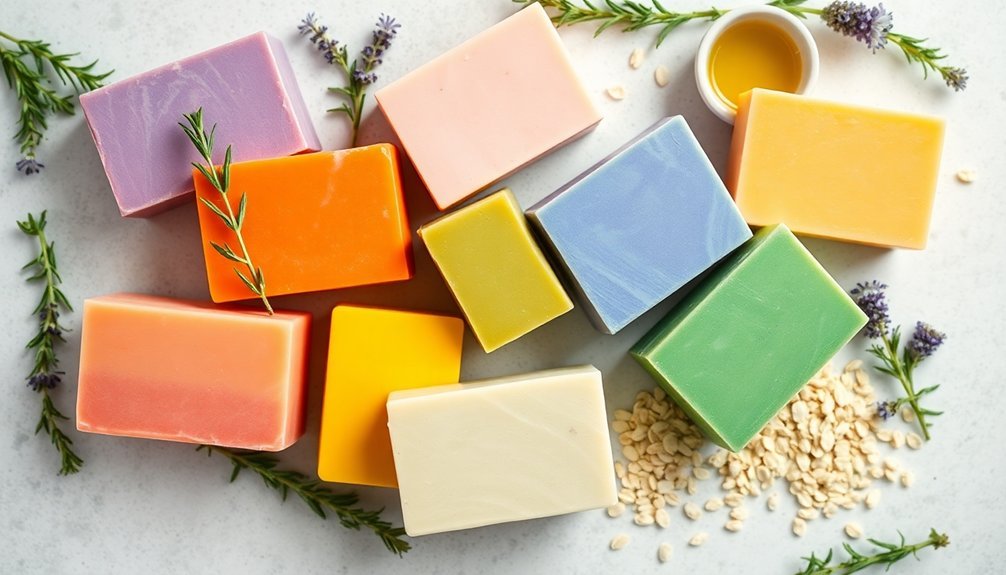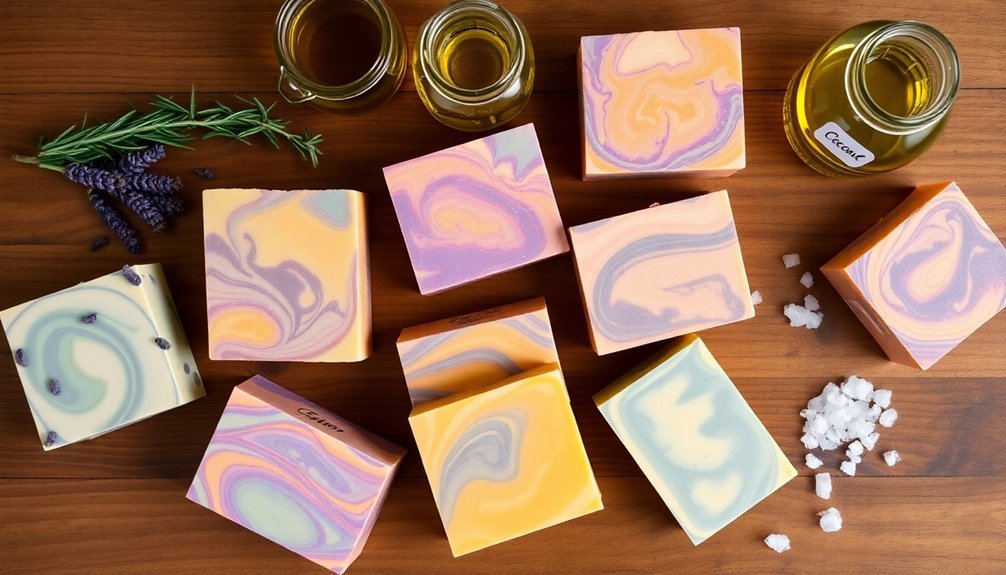You'll find that palm-free soap making isn't just eco-friendly—it creates superior bars for your skin. Try a basic blend with 75% olive oil and 25% coconut oil for balanced cleansing, a luxury recipe combining shea butter with coconut oil, or a sensitive skin formula using soybean and avocado oils with almond oil. Each recipe produces hard, moisturizing bars without harming rainforests or endangered species. Discover how simple tweaks to curing time and water content can transform your homemade soaps.
Why Choose Palm-Free Soap: Environmental Benefits and Skin Care Advantages

When considering your homemade soap journey, the choice to go palm-free carries significant weight beyond just crafting personal care products.
You're actively protecting rainforests and endangered species like orangutans while reducing carbon emissions from deforestation.
Palm-free soap typically contains gentler alternatives like olive and coconut oils, which provide superior moisturizing benefits and natural antibacterial properties.
These ingredients are less likely to irritate sensitive skin while delivering deeper hydration.
By avoiding palm oil products, you're helping prevent the displacement of indigenous communities whose ancestral lands are often cleared for large-scale palm plantations.
Essential Ingredients and Substitutes for Creating Hard, Moisturizing Bars
Five key ingredients form the foundation of successful palm-free soap making: coconut oil for hardness and lather, olive oil for moisturizing properties, shea butter for nourishment, sunflower oil for silky texture, and castor oil for enhanced bubbles.
The perfect palm-free soap begins with five essential ingredients, each bringing unique qualities to create a balanced, luxurious bar.
When replacing palm oil, you'll need ingredients that provide similar hardness and stability. Cocoa butter, kokum butter, or tallow can substitute effectively, though each brings unique properties to your soap. Adding salt to the lye water at a rate of 1/2 teaspoon per pound of oils can significantly improve the firmness of your palm-free bars.
To create hard bars without palm:
- Extend curing time to allow natural hardening
- Increase coconut oil percentage for immediate firmness
- Add sodium lactate or reduce water content
Balance is vital when formulating recipes. Combining hard butters with moisturizing oils like avocado or sweet almond creates bars that clean effectively while nourishing your skin.
Step-By-Step Palm-Free Soap Recipes With Varying Oil Combinations

Now that you understand the key ingredients for palm-free soaps, let's explore specific recipes you can make at home.
For beginners, try a simple 75% olive oil and 25% coconut oil blend for a 200-gram batch. This provides a good balance of cleansing and moisturizing properties.
For sensitive skin, combine soybean and avocado oils with a touch of almond oil.
If you're after luxury, mix cocoa butter with coconut oil for a harder, richer bar.
To create firmer bars without palm oil, reduce your water content, add a bit of salt to the mix, or extend the curing time beyond four weeks. Remember that these bars won't have the same cleansing properties as those made with palm kernel oil, which typically creates a bubbly lather.
For an innovative blend, try combining shea butter with rice bran oil—you'll get excellent moisturizing properties and improved hardness.
Frequently Asked Questions
Can I Use Regular Kitchen Equipment for Soap Making?
You can use kitchen equipment for soap making if it's stainless steel, glass, or heavy-duty plastic. Don't use aluminum or copper. Dedicate these tools to soap making afterward for safety reasons.
How Do I Troubleshoot Soap That Isn't Hardening Properly?
Check your lye measurements first. You'll need to guarantee proper oil balance, try adding hard oils, and consider water discounting. For already-made soft soap, rebatch it or give it more curing time.
Is Cold Process or Hot Process Better for Palm-Free Soaps?
For palm-free soaps, cold process is generally better as it allows longer cure time for naturally softer oils to harden properly. You'll get a smoother appearance, though you'll need patience during the 4-6 week curing period.
How Long Do These Palm-Free Soaps Typically Last?
Palm-free soaps typically last 2-4 weeks with regular use. You'll get the longest life from recipes high in coconut oil and shea butter. Proper storage on a draining dish will greatly extend your soap's lifespan.
Can I Sell Homemade Palm-Free Soaps Without Special Certification?
Yes, you can sell homemade palm-free soaps without FDA certification. You'll still need to follow FDA labeling guidelines, obtain general business licenses, and check your state's regulations for any specific local requirements.
In Summary
You're now ready to create amazing palm-free soaps that are kind to both your skin and the planet. With these three recipes, you'll enjoy the satisfaction of making sustainable bars that don't compromise on quality. Remember, you don't need palm oil to create hard, luxurious soap—nature offers plenty of alternatives. Start with the recipe that appeals to you most, and don't be afraid to experiment!





Leave a Reply